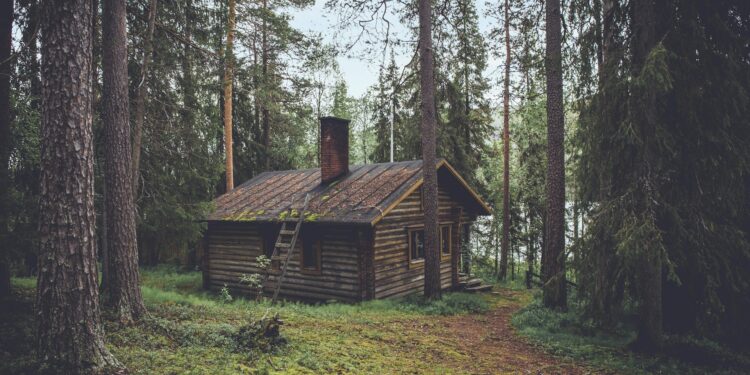A wooden façade of a house is a great way to add a unique character to it. However, it is worth remembering about several important aspects that are related to the laying and use of such a façade.
More and more often we can see modern houses with wooden facades. Such accents allow for optical modeling of the structure – depending on the arrangement, the house may become lighter, seem more extensive or slightly lower. In addition, this solution improves thermal and acoustic insulation. This is not only an aesthetic solution, but also a practical one.
Which wood to choose for the façade?
Before we decide on a specific type of wood for the façade of our house, it is worth comparing its properties with our needs and taste. Some types of wood are better able to withstand moisture (those with a higher resin content), while others may develop color changes over time.
Facade made of wood
The most common, as well as recommended, solution is to use local wood. Native raw material is much more predictable than exotic one, and this is because it grows in our climate. Thanks to this, you know how it will behave over time and how best to take care of it. A façade made of such wood will be durable and of good quality, as well as it will be cheaper and more easily accessible.
- Pine: due to the high content of resin, it is durable, resistant to loads, characterized by high annual growth (wide rings), this type of wood is available in colors from almost white to orange-brown.
- Spruce: resistant to heavy loads, high annual growth (wide rings), light wood colour, durable due to the high resin content.
- Larch: small annual growth (narrow rings), reddish-yellow colour, durable, easy to process and dry, unprotected changes colour to silver-grey (patina) or black-brown.
Facade made of exotic wood
Exotic wood, as mentioned earlier, can behave unpredictably in our conditions, which will make it more difficult to take care of it properly. This does not mean, of course, that we are doomed to surprises – we also have preparations available in the US to protect exotic wood. A house façade made of exotic wood is a more expensive choice, but it is supported by aesthetic values (interesting colors) and some technical aspects:
- Red cedar: stable wood with high resistance to weather conditions, has good thermal insulation properties, this type of wood comes in colors from beige to dark brown, has visible color variation within one board, over time changes color to silver-gray (patina).
- Siberian larch: small annual growths (narrow rings), very hardy, occurs in brown-honey-red color, over time it becomes patina (gray color).
- Scandinavian spruce: differs from the native spruce in the texture of the wood, it has fewer knots, which has a positive effect on its strength, small annual growth (narrow rings), the wood has a light color with a delicate yellow color (called white wood).
- Tatajuba: native to South America, the wood has a yellow-brown color that turns dark brown over time, resistant to changes in humidity and temperature.
- Okoume: native to Equatorial Africa, thanks to its characteristics it is perfect for the European climate, salmon-pink to dark pink color, smooth texture.
- Meranti: comes from the south-east. Asia, a large color discrepancy – from gray-brown, through red to dark brown, no knots, durable, although slightly sensitive to moisture (you need to impregnate more often).
How to install a wooden façade?
The installation of a wooden façade is not complicated, and there are many possibilities of its use. A wooden façade can be laid on both insulated and non-insulated or frame walls. The boards of the wooden façade of the house should be nailed to the impregnated wooden battens (grate) with nails (preferably twice as long as the thickness of the board) or fixed with screws.
Related: 12 Woodworking Projects for Preppers and Homesteaders
To avoid rusty stains on the façade, it is best to use galvanized screws that do not succumb to moisture. The grate should be matched to the boards, insulation and ventilation slot. The battens should be spaced every 40/60 cm, 3 to 5 cm wide and pressure impregnated. In frame structures, the grid is attached to load-bearing columns, and in a sandwich wall to the structural layer.
Wooden façade of the house – remember about care!
What should always be kept in mind – and preferably taken into account before making a decision and installing – is the need to care for the wood. In the case of a wooden façade of a house, regardless of the origin of the wood and its quality, we will have to clean and impregnate it regularly.
If we neglect to use appropriate products designed for this type of façade, we must take into account that it will start to deteriorate, and thus cease to be a decoration of our house. Therefore, it is worth seeking advice from a professional already at the stage of choosing wood and decide which one will be best for us, also knowing its care requirements.
You may also like:
 DIY: This Recipe Heals Your Knees And Reconstructs Bones And Joints Immediately!
DIY: This Recipe Heals Your Knees And Reconstructs Bones And Joints Immediately!
US Nuclear Target Map. Do You Live In The Death Zone? (Video)
How To Prepare Your Car In Case You Have To Live In It




















